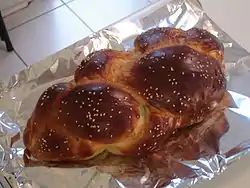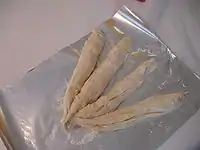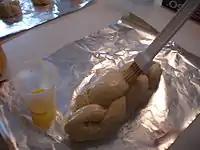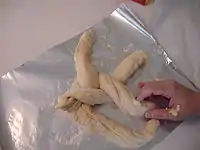Cookbook | Ingredients | Recipes
| Challah | |
|---|---|
 | |
| Category | Bread recipes |
| Servings | 4 challahs |
| Time | 5 hours |
Ingredients
Procedure
- Put nine cups of bread flour in a bowl.
- Add 1/2 cup of sugar, and 1 tablespoon of salt.
- Mix.
- In a small bowl or large measuring cup, put 1.5 cups of warm water.
- Add 1 tablespoon of sugar and mix.
- Sprinkle 6 3/4 teaspoons of dry yeast on top.
- Wait 8 minutes.
- Mix the yeast mixture and add it to the flour mixture.
- Mix.
- Add 4 eggs and 1/2 cup of oil.
- Mix.
- Add about 1 cup more warm water and knead the dough for about 10 minutes.
- Let the dough rise, covered, for two-four hours.

Braiding
- Divide the dough into four parts. These will make 4 challahs.
- Take one part. Separate it into four pieces. Take each piece and roll it between your hands until it is a long strand. Attach the four strands together at one end by squeezing the ends together. See picture.
- Place on a piece of foil or a pan.
- Take the strand at the far left and braid by putting it over two strands to the right and then put it back under one strand to the left.
- Take the strand at the far right and put it over two strands to the left and then put it back under one strand to the right.
- Repeat the last two steps until you reach the end of the strands.
- Do the same thing with the other three parts.
Finish

- Paint with beaten egg.
- Sprinkle with sesame seeds.
- Allow to rise for two hours.
- Bake in preheated oven at 400ºF (200ºC) for 25 minutes.
Conversion Notes
- ↑ Weight conversions from USDA National Nutrient Database. Original recipe text and ingredient order preserved. Used "1/2 cup plus 1 tbsp" for sugar conversion. Active dry yeast, large eggs, and soybean oil presumed. Density adjustment not applied to warm water.
- ↑ This excessive amount of yeast will result in a strong yeast flavor. To reduce this flavor, it is recommend to use no more than 0.75% instant dry yeast which means about 9.24 g, or about 2 1/4 teaspoons, although you can expect fermentation time to increase slightly. Osmotolerant yeast may be desired for optimum results.
This article is issued from Wikibooks. The text is licensed under Creative Commons - Attribution - Sharealike. Additional terms may apply for the media files.
